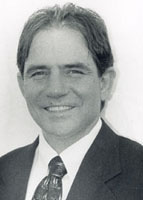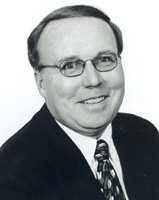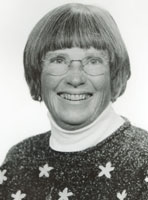




Doug Adams
Clio/Flint Powers
Grand Rapids Christian
Whitehall
Grand Rapids Catholic Central
 |
|||
|---|---|---|---|
 |
 |
 |
 |
Doug Adams |
Jerry Bentley Grand Rapids Christian |
Dick Morley Whitehall |
Patricia Williams Grand Rapids Catholic Central |
(click on Inductee's name to read 'description')

Some tennis coaches have played our sport throughout their youth and developed such a love for the game that they went into coaching, both to keep themselves immersed in an activity that they love and to give back something of what they had received. Others were converted late in life, fell in love with our sport and all of its possibilities for what it can do for young people, and then threw themselves into learning the game with the zest of a true believer. Doug Adams belongs in the latter category and as he himself puts it: "I had no comprehension of how rewarding coaching could be. It has changed my life."
As the last and only hope to rescue Clio's program from being dropped, Doug had the good fortune to have learned the basics of tennis some months earlier in an introductory college tennis class. Lesson plans prepared by his predecessor and demonstrations by the #1 singles player got him through the first season. The previous coach said: "hand out the flyers for each lesson and discuss the main points. Tell them that Sally will now demonstrate. And do not let them see you hit a ball!"
But dedication to learning tennis through lessons at a local club, reading various publications, joining the MHSTeCA, attending its clinics, joining the USTA as a lifetime member, and spending many hours on the court changed all that. He was eventually recruited to coach the Flint Powers girls team in 1986. The rest is history.
And what a history. Although literally pulling kids out of the halls and off the sidewalks to field complete teams, Doug increased participation in the Clio boys and girls programs to the point that JV teams had to be added. He led the Clio boys and girls teams to their first victorious seasons, won a regional championship, and qualified for back-to-back trips to the state finals, considerable accomplishments for a non-tennis community. Under his direction, the Flint Powers girls won their first league championship and then added four more. He led this same girls squad to their first regional title and then added 11 consecutive championships. Over the past 20 years, his teams have won 24 invitational tournaments and over 300 dual meets.
Doug, of course, doesn't merely take home the trophies but characteristically gives back. Over the years, he has hosted dozens of invitationals, several league tournaments, and two regional events. He has often helped others run tournaments, including the state championship, as a site director, and numerous times has been found on the court serving as a line judge.
Going even beyond the fall and spring seasons, Doug has also organized and managed summer doubles leagues for 17 years, building them up to 4 leagues with 42 teams meeting on two different nights. These leagues involve players of a variety of skill levels from Flint Powers, Clio, other area schools, and the Clio community in general. He helped convince the Clio Board of Education to resurface their courts and the Powers board to add three more to their facility.
In addition, Doug serves the MHSTeCA as an active member of the board of directors, a consistent provider of rankings information, and our Historian. All of this has not gone heretofore unnoticed. Doug was named our association's Girls Class A Coach of the Year in 1988 and Girls Class B Coach of the Year in 1996. He served a two-year term on the MIASAA Tennis Committee, a responsibility that goes to well-informed, respected coaches.
One of his former players once said about Doug: "He cares about us before winning." Another declared: "He teaches us how to be good people as well as good players." Rival coaches praise both the excellence of his program and the ethics of his character. He has been described as "the quintessential representative for tennis as a lifetime activity," as he combined his love of the sport with great motivational skills.
Doug is so highly regarded at his school that he assumed the position of assistant principal at Cilo High School two years ago. Unfortunately, the demands of the job have required him to give up his two coaching positions. However, he will be able to put a well-deserved hall of fame plaque on the wall of his office signifying to all who enter that, for the previous 20 years, he was one of the most effective coaches that we had.
In a moving hall of fame presentation last year, highly-regarded Grand Rapids teaching pro Jorge Capestany described how a "dressing down" following a disgraceful loss by his tennis coach Rahn Bentley became a significant emotional experience that changed his life. When Jerry Bentley accepted the award on behalf of his deceased brother, he, too recounted the incident as one which altered his own life. As Rahn's assistant coach at Hudsonville, Jerry was there to hear every word of that episode. The impact of it became an inspiration that produced a vision for him of what both a competitor and a tennis coach can accomplish.
"Accomplish" in this context means changing lives, not merely racking up total wins. After all, Jerry has worked in the inner city trenches for 22 years. One of 11 children, he learned the game, in part, using a rough and tumble variation of Jean HoxieÕs famous wall. As he put it: "the older boys, Rahn, Mark, David, and Wayne, would line us younger ones up on the old factory wall in the parking lot across the street from our inner-city house. We would have to shuffle the length of the wall on a one-foot ledge while the big boys fired shots at us from a line that we thought was too close. If we caught the ball we would get to take the older boy's place. This is I where got my [quick] hands and my side-to-side shuffle."
However, because he was too young to play with "the big boys," Jerry wasn't actually much interested in playing tennis until he got to high school where he felt pressured to succeed in this sport, largely due to the heralded Bentley family tennis tradition. Since the brothers who preceded him had played al the top positions of their respective tennis teams, Jerry felt compelled to emulate them. He played 25 in his 10th and llth grade years and ill as a senior.
But Jerry didn't really get into the sport until he went to work as RahnÕs assistant in Hudsonville. He did the physical part when his brother was confined to a wheel chair, an experience that both taught and inspired him. When he secured the girls job at Grand Rapids Creston in the late 70s, he was prepared. Thanks to Rahn, he became something of an expert in teaching kids to learn from their losses.
Since the vast majority of his players could not afford club lessons, Jerry created the Creston Tennis Camp, a project that has grown from 11 kids that first year to over 70 players with 6 coaches. Throughout the years, he has welcomed everyone to this program including kids who would turn around and compete against his teams during the high school seasons. What he created, with the help of coaches such as Patricia Williams, was, in actuality, a family atmosphere in which "his own kids beat his own kids" in good-natured rivalries. This situation became so gratifying that Jerry turned down an opportunity to become the assistant coach at highly-successful East Grand Rapids.
Jerry's career is filled with stories of kids who came to him in street shoes and a 1960s wooden racquet, only to emerge at the end of four years as proficient players who occasionally won city championships. He is especailly proud of a boys team which went fro 1-11 in hisfirst year as coach ("We would home from the regional tournament at 10:30 on Friday morning") to 9-3 threee years later. He invariably attended regional seeding meetings even though none of his kids had realistic chances of being seeded. He felt that it was his responsibility as a coach to be there.
Jerry's summer camp has fostered an environment over the years that looks upon losses as learning experiences. As he says "Some of the girls thought I was crazy because after a defeat I would tell them how happy I was for them" His players were always competitive and his teams were usually in the top three of the Grand Rapids City League. But more importantly, he taught his kids how to deal with both victory and defeat. For this and much more, he is awarded our ultimat victory: induction into the MHSTeCA Hall of Fame.
Michael Boozy, superintendent of the Muskegon Intermediate School District, once wrote: "Whitehall tennis has reached the status of a major sport. In my years of association with the school district as high school principal, superintendent, and parent, tennis has emerged significantly in the culture of this community and thrives in the lives of its students. This may be attributed single-handedly to a coach..."
W ho, of course, is Dick Morley. But when Dick agreed to coach tennis back in 1970, he had no idea that the team had labored under 5 different coaches over the previous 5 years, that they had a 77 dual match losing streak, that kids went out for tennis to get a varsity letter because they could not earn it in any other sport, and that seemingly nobody knew anything about (or for that matler cared about) the sport. Expectations were so minimal that there were no courts, there was no equipment, and there were no uniforms. In addition, the program endured the constant threat of being eliminated. In spite of all this, Dick led his team to a school record of5 dual meet wins that first season, coached his first state qualifier in 1976, and began a summer program. Although tennis was eliminated in 1979, the first nine years planted the seeds for a program that has become truly impressive.
Since 1985 when Dick resumed his quest, consider what he has accomplished:
Dick has succeeded in making tennis in his community an affair around which many families focus their time, energy, and resources. As Ronn Nelson, one of his parents, once wrote: "He builds a team, then takes it to the next level and builds a family." Team meetings are sometimes held in front of parents and peers. The girls go to Hilton Head before each season and the boys train in Florida during the spring break. He takes them everywhere in the summer to play in tournaments.
But more importantly, these kids receive the benefit of a philosophy that embraces values that go beyond wins and losses. Players and parents effusively praise his caring attitude: He is as genuinely concerned about the psychological welfare of the "lesser-lights" as he is about the stars. He took Jeff Nelson, a player who had just undergone eye surgery, to Florida so that he could recover amidst team encouragement, even though Jeff couldnÕt compete with the team. In his summer program, he worked with and encouraged Katy Clay, a struggling player at the time who didnÕt even live in the Whitehall area (She played successfully for Fast Grand Rapids) to such an extent that she wrote her Senior Essay, the one which was submitted as part of her college pplication, about his impact on her life.
A person outside the team once accused Dick of creating an elitist program. Dick replied that he agreed, with one exception: the program was open to everyone. Indeed, lie has succeeded in taking the ordinary and developing it into something extraordinary. lIe has then gone on to line-tune this activity into a vehicle for good work that makes him worthy of the highest laurel: induction into the hall of fame.
Although she has eight children, Patricia Williams is by no means a stay-at-home mom. Currently a mathematics instructor at Davenport College and Discovery Toys Educational Consultant, she has been a licensed day care provider, a freelance computer programmer, a Grand Rapids Public Schools teacher in the Lighthouse Program Gifted Children, and in her spare time, made and sold craft items. Her resume is replete with school volunteer activities: treasurer of both the Kent County Association for Gifted and Talented and the St. Thomas boosters, commissioner of two St. Thomas committees, designer and organizer of a 4th of July parade float, coach of her school's Battle of Books team, supervisor on field trips and playground duty, and math tutor. However, even considering this amazing scope of activity, it was still no surprise to many that in 1973 when Grand Rapids Catholic Central asked if she would coach tennis, she jumped at the opportunity "because of my strong feelings of delight that girls finally had a chance to play."
This was because as a high school player, Patricia didn't have quite the same opportunity to participate on a school team even though she was an accomplished player who became Grand Rapids City Champion at age 16, played in inter-city matches, played on the Junior Wrightman Cup team, and reached the semi-finals of a summer state tournament in both singles and doubles. Ever the innovator even back then, she organized team tennis in high school in order to play girls from East Grand Rapids and Ottawa. These kids competed and then called their scores in to the G;rand Rapids Press. She attended Aquinas College where she played #1 singles and #l doubles all four years, frequently practicing with the men's team.
Ever the advocate of large numbers, so it seems, Patricia approached her job of coaching tennis at Catholic Central in the same mode. She refused to cut students from the team which meant that, given the 45-65 player turnout each season, she was running two and sometimes three practices per day. The only thing she asked for in those early days was babysitting money and assistant coaching help. She got it, especially in terms of assistants who, over the years, came from the extensive lists of her former players. These assistants were on hand when Patricia sometimes delivered a baby just prior to a contest but she would invariably be found soon afier, baby in tow, either watching or coaching, but always providing a reassuring presence.
Given the large numbers of participants and the widespread interest tennis in her area, Patricia spent considerable time, not only on the court but also on the phone. She recruited volunteer coaches. She called area coaches to arrange JV matches. She made sure that her players were particiPatriciaing in offÐseason programs, especially in the summer when she helped Jerry Bentley run his program at Aberdeen Park. And she successfully lobbied for new courts both at the park and at Catholic Central. All of this was accomplished while raising eight kids who are, by all accounts, successful people, model citizens, and strong tennis players.
In her formative years, Patricia, who was taught the fundamentals of the game by her father, in turn helped teach her younger brothers and sister whenever she could. She made this "teach the younger ones" activity the focus of a solid career in which she raised a large tennis family both at home and at her school. As she puts it, "1 felt that I was also a lesson in family life for my players." Indeed, she had four boys of her own before the first daughter came along and used to say facetiously that she had boys at home and girls [the teami at school. When her first daughter was born, she named Anne after the girl's name on her team that she liked the best. When her oldest boy was a junior in high school, she leaped again at the opportunity to coach the boys team after the current coach quit. This meant that she could coach her sons as well.
In other words, Patricia Williams has made a career of coaching a family of tennis players. That family has extended well beyond eight siblings to include a vast number who will testify that some of the finest moments of their lives were spent playing for this exceptional woman. Many have gone on to play college tennis and some have either returned to help her with the team or are coaching their own teams. Such proliferation constitutes an exceptional legacy, one in which membership in the hall of fame seems particularly appropriate.